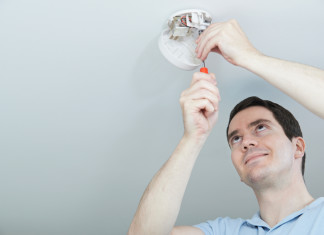Often described as the unseen killer, carbon monoxide (CO) is a toxic gas that can be present in the most unsuspecting locations. Odorless and tasteless, carbon monoxide is created as a byproduct of the combustion of fossil fuels and often accumulates in warehouse and loading dock areas as a result of heavy forklift and vehicle emissions.
The broad line of defense in protecting workers and equipment from CO are fixed-point gas detection systems. CO systems typically consist of monitors that utilize electrochemical sensors strategically placed at sensitive points throughout the facility, which may then communicate gas exposure data back to a variety of command or control centers.
Proper placement
Since traditional fixed-point gas detection systems are hard-wired and, therefore, difficult and expensive to move, it’s important to place sensors in the right place the first time. Alternative technologies, such as wireless systems, reduce installation or relocation costs but do not circumvent the issues concerning appropriate placement of gas sensors.
There are four primary considerations for placing fixed-point gas detection system sensors:
(1) Gas release & collection points
Common sense dictates locating sensors as near as possible to potential release points and collection points, where hazardous gases could be most threatening. However, release and collection points may not even be situated at the same site. For example, a potential CO release point may be located at an adjacent plant or parking garage.
To determine the most likely gas release points, conduct a walk-through audit and review all drawings of your facility including process and instrumentation diagrams. Using these documents, evaluate your facility’s possible sources of CO such as furnace and boiler rooms, high-traffic loading bays, and warehouses and transportation routes where internal combustion engines may be used.
Identifying collection points - areas where gases could potentially build up - requires a review of the facility’s layout. Note where people are permanently stationed for work or where they may regularly congregate, such as production areas, storage facilities and loading docks, as well as evacuation and exit routes. Gas detectors used to monitor collection points should be positioned between the release and collection points.
Because collection areas are usually the most populated places, single-point monitors with sensing display and alarm functions are recommended in these locations.
(2) Weight of gas
The density (or weight) of gas vapor is a key criterion in positioning gas detection sensors in terms of height. Heavier-than-air gases, such as chlorine and hydrogen sulfide, tend to sink and collect in low places. By contrast, sensors for lighter-than-air gases, such as methane and hydrogen, should generally be located above the danger point.
Sensors for gases with the same density as air should, therefore, generally be located at or near the “breathing zone” of humans, approximately five to eight feet above the floor. Although CO is slightly lighter than air it tends to blend well with air, and by placing sensors five to seven feet above the ground, they may provide a warning before toxic conditions occur. This placement also moves the sensor out of the direct path of most vehicle exhaust outlets, providing a more representative sample of the area.
(3) Air flow direction & velocity
Since gas is affected by the direction the atmosphere is moving, factor ventilation patterns and air currents into sensor placement. Generally, you should locate the sensors upstream where prevailing air current would likely contain the maximum concentrations of the monitored gas. For outdoor placement, anticipate potential changes in wind direction at different times of the day or during different seasons.
(4) Indoor or outdoor monitoring
When monitoring large areas indoors, be mindful of grade, floor and operating levels, as well as air flow from heating/ventilation systems. Check not only for possible leak sites, but also for any penetrations and other points of entry where gas can be introduced into a closed area.
When monitoring specific indoor equipment, position sensors between one and seven feet from the potential leak source. To some degree, you can control the sensitivity of the sensor by moving the head closer to the source point. Sensors placed between two closely aligned source points often can serve both of them.
Outdoor gas monitoring is significantly more complex because gas behavior is impacted by such variables as wind, condensation and terrain.
Points of interest
Common release points of carbon monoxide:
- Boilers and furnaces
- Vehicles that use internal combustion engines (forklifts, cars, trucks)
- Any location where fossil fuels are burned (natural gas, oil, wood, coal)
Common collection points of carbon monoxide:
- Boiler rooms and furnace rooms
- Truck loading bays or internal combustion engine shelters
- Administration offices
- Confined spaces
- Maintenance shops
- Faculty air intakes



































